I believe that Global warming is definitely a problem for Canada. We are the closest to the north pole which obviously means theirs a little cap of snow above us which is extremely important to the wildlife there that affect the ecosystem in the arctic along with also affecting the ecosystem more south.
Some factors that contribute to settlement would be water for the power and survival of the population. A flat or large area that doesn’t block transportation for people and their cars. Also the weather because we generally want to live in a warm enough climate that we dont have to dress in heavy clothing all the time but not so hot that we cant function properly.
If the Globe warmed the increase in temperature would move up. Causing many changes.
Arctic: Because people already live with extremely low temperatures. If the globe was to get any warmer i think the people would move. Maybe spread out even more to the top of the arctic land if they could.
Cordillera: Because there are mountains it would make it difficult for the people to move up so i think they would spread into the plains or along the edge as much as they can.
Plains: they would move farther up south, spreading.
Shield: Stay or move into the upper region of the plains
St.Lawrence:The people here would start spreading from where they already are to the shield and plains.
Appalachian region: The people here would spread maybe more into the west towards Quebec. The warmer climate could make their farmland even more successful probably keeping a large chunk of the population there.


















